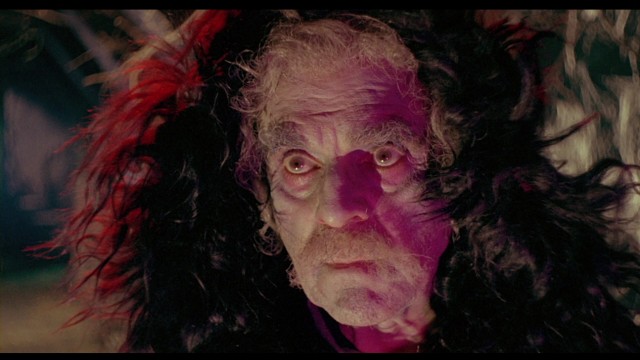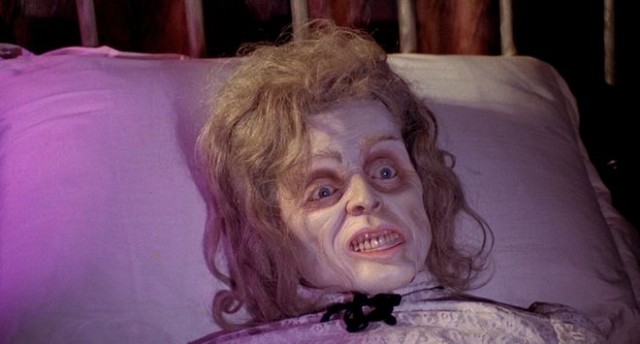BLACK SABBATH (Mario Bava, 1963-64)
Anthology Film Archives
32 Second Ave. at Second St.
Saturday, August 1, 6:45, Tuesday, August 4, 7:00, and Saturday, August 8, 9:00
Series runs through July 31 – September 3
212-505-5181
anthologyfilmarchives.org
 The film that gave Ozzy Osbourne’s band its name, Black Sabbath is just about everything you could want such a movie to be: cheap, exploitive, and featuring Boris Karloff, with nods to great French and Russian storytellers. (Um, sure . . . of course.) Founded in 1954 by James H. Nicholson and Samuel Z. Arkoff, American International Pictures was responsible for hundreds of low-budget independent films through 1980, specializing in horror, Westerns, blaxploitation, sci-fi, biker flicks, teen delinquency, women in prison, and even beach movies. Anthology Film Archives is paying tribute to the famed studio with a three-part series that begins July 31 by focusing on auteurs who either cut their teeth with AIP or were already well established. It’s quite a list; through September 3, Anthology will be screening works by Francis Ford Coppola, Martin Scorsese, Vincente Minnelli, Brian De Palma, and Roger Corman, who will make several appearances at the downtown movie house. Also on the roster is Italian scaremaster Mario Bava, whose Black Sabbath will be shown August 1, 4, and 8. Black Sabbath is, appropriately enough, an anthology of three short films hosted by Boris Karloff, a kind of melding of Karloff’s Thriller television series with Rod Serling’s Twilight Zone. The Italian-French coproduction was significantly changed by AIP, altering the order of the films and drastically modifying one of the plots. Black Sabbath opens with “A Drop of Water,” supposedly based on a short story by Anton Chekhov. Late one night, nurse Helen Chester (Jacqueline Pierreux) is summoned by an elderly caretaker (Milly Monti) to a stately home where a medium — sporting perhaps the most frightening face ever on a dead person, with dark, deep-set eyes and a viciously wicked smile that makes her look like an evil doll — has died during a séance. After stealing the medium’s ring off her finger, Helen is suddenly taunted by a buzzing fly and drops of water, evoking what was experienced by the killer in Edgar Allan Poe’s “The Tell-Tale Heart,” who was haunted by the unending sound of a beating heart. (Perhaps not coincidentally, AIP was famous for its Poe adaptations.) The conclusion is truly chilling, with a cool little coda.
The film that gave Ozzy Osbourne’s band its name, Black Sabbath is just about everything you could want such a movie to be: cheap, exploitive, and featuring Boris Karloff, with nods to great French and Russian storytellers. (Um, sure . . . of course.) Founded in 1954 by James H. Nicholson and Samuel Z. Arkoff, American International Pictures was responsible for hundreds of low-budget independent films through 1980, specializing in horror, Westerns, blaxploitation, sci-fi, biker flicks, teen delinquency, women in prison, and even beach movies. Anthology Film Archives is paying tribute to the famed studio with a three-part series that begins July 31 by focusing on auteurs who either cut their teeth with AIP or were already well established. It’s quite a list; through September 3, Anthology will be screening works by Francis Ford Coppola, Martin Scorsese, Vincente Minnelli, Brian De Palma, and Roger Corman, who will make several appearances at the downtown movie house. Also on the roster is Italian scaremaster Mario Bava, whose Black Sabbath will be shown August 1, 4, and 8. Black Sabbath is, appropriately enough, an anthology of three short films hosted by Boris Karloff, a kind of melding of Karloff’s Thriller television series with Rod Serling’s Twilight Zone. The Italian-French coproduction was significantly changed by AIP, altering the order of the films and drastically modifying one of the plots. Black Sabbath opens with “A Drop of Water,” supposedly based on a short story by Anton Chekhov. Late one night, nurse Helen Chester (Jacqueline Pierreux) is summoned by an elderly caretaker (Milly Monti) to a stately home where a medium — sporting perhaps the most frightening face ever on a dead person, with dark, deep-set eyes and a viciously wicked smile that makes her look like an evil doll — has died during a séance. After stealing the medium’s ring off her finger, Helen is suddenly taunted by a buzzing fly and drops of water, evoking what was experienced by the killer in Edgar Allan Poe’s “The Tell-Tale Heart,” who was haunted by the unending sound of a beating heart. (Perhaps not coincidentally, AIP was famous for its Poe adaptations.) The conclusion is truly chilling, with a cool little coda.

Boris Karloff serves as host of Mario Bava’s eerie anthology film BLACK SABBATH and plays one of its creepier characters
In “The Telephone,” the glamorous Rosy (Michele Mercier) returns to her apartment one night after an undisclosed outing and is harassed by a man who keeps calling her on her awesome black and red phone, the severity of his threats growing each time she picks up. When the man claims to be the recently deceased Frank, she turns to a former friend, Mary (Lydia Alfonsi), for help, but it’s going to take a lot more than that to save her from this supernatural peril. The Italian original had a tasty soupçon of lesbianism and prostitution, which was washed clean by AIP, but “The Telephone,” possibly inspired by works by F. G. Snyder and Guy de Maupassant, is still a creepy little story that holds up well in this surveillance-crazed age. The trilogy of terror concludes with the heavily atmospheric vampire yarn “The Wurdalak,” adapted from a novella by Aleksey Nikolayevich Tolstoy. In nineteenth-century Russia, a family awaits the return of its patriarch, Gorca (Karloff, looking like a cross between the Grinch, the Gremlin from the 1963 Twilight Zone episode “Nightmare at 20,000 Feet,” and the Abominable Snowman), who has gone off to kill a wurdulak, a living cadaver that feasts on the blood of loved ones. Gorca’s son Giorgio (Glauco Onorato), Giorgio’s wife (Rika Dialina), their young son, Ivan, and Giorgio’s younger siblings, Pietro (Massimo Righi) and Sdenka (Susy Andersen), are joined unexpectedly by Vladimir Durfe (Mark Damon), a traveling nobleman who discovers a man with a knife in him outside the family’s cottage. But when Gorca finally shows up, there is something different about him, and the members of the clan must decide whether he’s still their father or if he’s been turned, coming home to feast on his family.
Black Sabbath might be minor Bava, but it’s a great place to start if you know little or nothing about the Italian director, who made such other films as Black Sunday, The Girl Who Knew Too Much, Dr. Goldfoot and the Girl Bombs, and Kill, Baby, Kill before passing away in 1980 at the age of sixty-five. Black Sabbath has that classic Bava look and feel, with colorful, lush sets, eerie cinematography by Bava and Ubaldo Terzano, captivating suspense, and essentially competent acting with questionable dubbing. Karloff has a ball both as the host of the whole thing and the star of the third film, chewing up the scenery with his playful eyes and mocking brow. He would go on to make a bunch of films for AIP, including Corman’s The Terror and The Raven, Daniel Haller’s Die, Monster, Die! and Jacques Tourneur’s The Comedy of Terrors, alongside such fab costars as Jack Nicholson, Vincent Price, and Peter Lorre. American International served as a training ground for up-and-comers as well as a last bastion for aging actors and directors, and the strange and scary Black Sabbath fits right into their majestic raison d’être.
